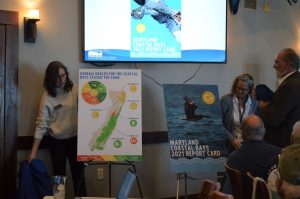
WEST OCEAN CITY – The overall health of the coastal bays remained the same last year, according to a new report card on Maryland’s coastal bay system.
On Monday, the Maryland Coastal Bays Program – in partnership with various state and national agencies – released its Maryland Coastal Bays 2021 Report Card. Measuring water quality and biotic indicators, the report issued this week gave the coastal bays a C+ in overall health.
“We’re really at a tipping point today,” said Kevin Smith, executive director of the Maryland Coastal Bays Program. “A C+ is okay, but it’s certainly not great.”
Each year, the Maryland Coastal Bays Program, University of Maryland Center for Environmental Science, the Maryland Department of Natural Resources and its partnering agencies release a report on the health of Maryland’s coastal bays by measuring the levels of chlorophyll, dissolved oxygen, nitrogen, phosphorous, seagrass and hard clams in six regions – Assawoman, Chincoteague, Isle of Wight, Newport and Sinepuxent bays and the St. Martin River – and issuing a grade.
According to the 2021 report card, the overall health of the coastal bays saw no significant change from 2020, when the coastal bays watershed received the same C+ grade.
“The only difference between this and the last report card is our phosphorous is a tiny bit better,” said Bill Dennison, representing the University of Maryland Center for Environmental Science. “It’s moved from the moderate category to the good category.”
Overall, the report gave total nitrogen and chlorophyll levels the highest rating and seagrass and hard clam levels a “poor” rating.
The highest scoring region was the Sinepuxent Bay with a B grade, while Chincoteague Bay followed closely behind with a B- grade. The lowest scoring region was the Newport Bay, with a D+ grade. The report states Newport Bay had three indicators that received D’s and F’s, and only one indicator that received a B.
“There are some good things out there,” Smith said. “St. Martin River, for example, is improving. But there are things that aren’t so great, such as Newport Bay, which doesn’t appear to be improving. It actually appears to be degrading.”
Officials this week also highlighted successful programs aimed at improving the health of the coastal bays, including a Salt Marsh Assessment and Restoration Team initiative and a nesting platform project.
“It’s getting us to where we can restore island habitat to keep our nesting shorebirds here,” Dennison explained.
Smith, however, said more work needed to be done.
“A C+ is okay, but we want to see this get better down the road …,” he said. “Things don’t happen overnight. But for us, it means we have to continue down the road we’re on until we see these rates improve.”
The Maryland Coastal Bays Program and its partnering agencies also released its 2022 State of the Coastal Bays report, which evaluates scientific advances and highlights emerging issues.
Dennison noted the theme of this year’s report is building ecological resilience.
“The two key words of this report are ‘building resilience …,’” he said. “Because the pace of change is accelerating, we need to be talking about building resilience so that these systems will be here for the next generation.”
The Maryland Coastal Bays report card can be viewed online at marylandcoastalbays.ecoreportcard.org.

